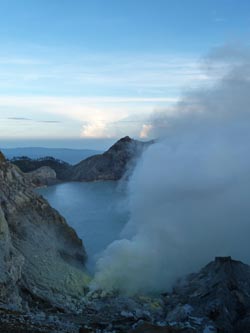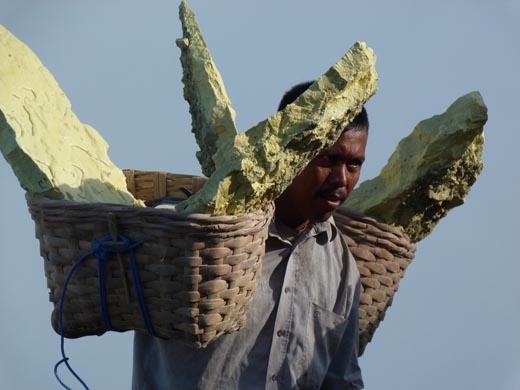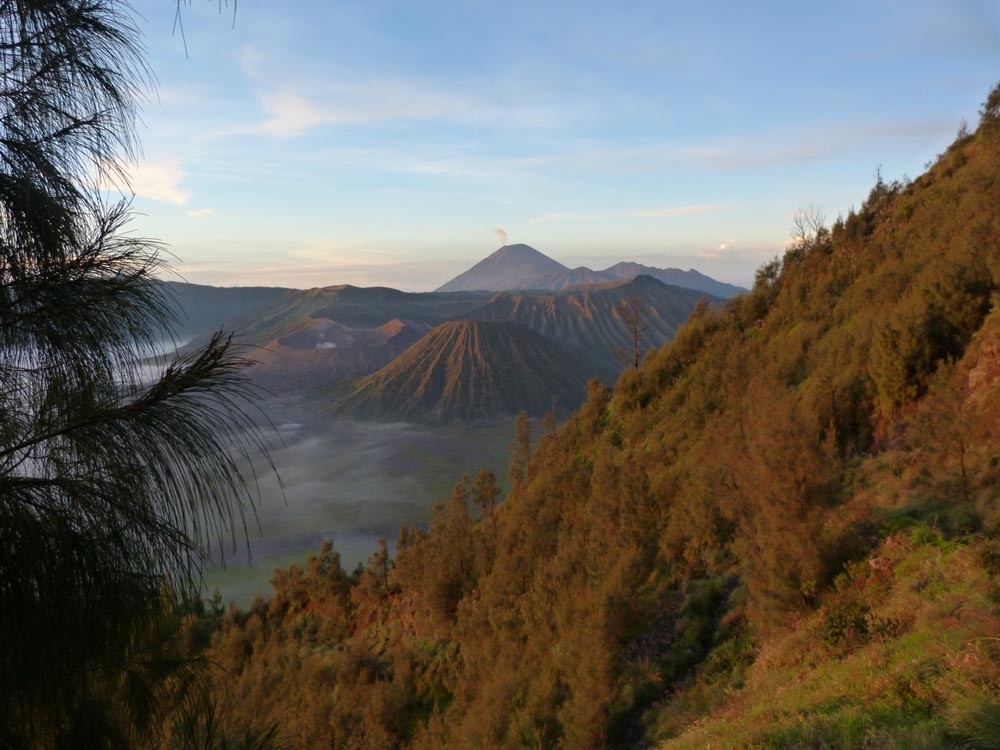- Details
- Written by: Mike Walker
Bromo Tengger Semeru National Park is not your average mountain range. Lying in the heart of East Java in Indonesia, you won’t find snow-capped peaks, lush valleys or raging rivers, and there are definitely no rock faces or great walls of ice.
Here, nature does things a little differently. The whole country could arguably be described as one giant chain of volcanoes, but in this particular part, a handful line up one behind the other in the most bizarre yet stunning of settings.
The park is actually a giant crater and the volcanoes sit within it, surrounded by a desert of ash-coloured sand. Each volcano can be climbed – the highest being Mount Semeru (3,676m) – but the finest views are to be found by scaling a peak just north of the outer rim, called Penanjakan.
From here, the smoking crater of Mount Bromo occupies the foreground, while the towering summit of Semeru dominates the backdrop, completing a vista that genuinely takes the breath away. The various volcanoes are wildly different in their formation yet complement each other beautifully to create an image that looks like it comes from another planet.
The best time to make the short ascent up Penanjakan is ahead of daybreak, ready for the rising sun to slowly illuminate the volcanoes orange, chestnut brown and finally leaf green. Most visitors hire 4x4s to drive them up to a viewpoint on Penanjakan’s summit in time for first light, but the better option is to make the two-hour hike on foot. Although the first section is on the roadside, the going soon gets too steep for vehicles and a quiet, narrow trail becomes the only way up the mountain.
A 4am start will see dawn begin to break halfway up the peak, meaning that as the colours change, so too does your perspective of the volcanoes. Lower down, only Bromo and the ridged flanks of the neighbouring Gunung Batok can be seen, but as you climb further, the summit of Semeru begins to appear in the far distance, revealing more and more of its lower slopes with every upward step you take.
Whether high up or low down on Penanjakan, the only constant is that Bromo Tengger Semeru National Park never fails to disappoint. After reaching the top and reliving the journey in reverse with a gentle descent, there is just enough time before the late-morning clouds roll in to hike down into the crater itself and make the 45-minute walk to Bromo, a highly active volcano that long since blew its top and is now just a great bowl.
The walk is worthwhile as much for experiencing the moon-like landscape of the caldera floor – or ‘Sea of Sand’, as it is known locally – as it is for the views of Bromo’s enormous crater and the continuous plume of smoke that belches out of it.
I had wanted to then trek 12km south and spend two days climbing Semeru, but visiting at the back end of Indonesia’s wet season meant the mountain was closed, so I instead made a six-hour journey east to another volcano that was equally as intriguing as Bromo, albeit for very different reasons. Kawah Ijen stands in the 20km-wide Ijen caldera, near to the eastern coast of Java and just a short drive and ferry ride away from Bali. The ascent to the edge of its crater takes just over an hour and is once again best started before dawn in order to enjoy the sight of the rising sun shining its dimmed rays on neighbouring peaks. A well-marked path winds around the mountain’s southern flank and emerges from the treeline just in time for first light.
Kawah Ijen stands in the 20km-wide Ijen caldera, near to the eastern coast of Java and just a short drive and ferry ride away from Bali. The ascent to the edge of its crater takes just over an hour and is once again best started before dawn in order to enjoy the sight of the rising sun shining its dimmed rays on neighbouring peaks. A well-marked path winds around the mountain’s southern flank and emerges from the treeline just in time for first light.
Whereas Bromo Tengger Semeru National Park is unearthly and barren, the Ijen caldera is lush with thick forest that changes colour as the sun slowly encroaches on the slopes of its volcanoes. The feeling of peace does not last, though, because higher up, Kawah Ijen offers a unique insight into the explosive power of nature.
The smell of sulphur is already thick in the air by the time the volcano’s crater appears around one final turn in the trail, but the sight of its great rock walls plunging down into a turquoise lake is nevertheless surprising. The eye is not drawn to the water, though, but rather the closest shore, where an enormous plume of smoke rises up from an eruption of sulphur.
There are only a handful of places in the world where you can look so deeply into the inner workings of the planet and, on closer inspection, it is even possible to spot miners hacking away the newly formed yellow rock. These men make a dangerous and back-breaking living from hiking down into the crater, cutting away up to 90kg of sulphur and then hauling it back out of the volcano using wood and wicker baskets balanced delicately on one shoulder. 
Indonesia’s volcanoes still aren’t at an end at Ijen, though, because east over the nearby channel and into Bali stands another chain of active and attractive peaks that can also be easily explored on foot.
I had wanted to tackle the island’s highest, Mount Agung (3,142m), but was yet again thwarted, this time by a cultural festival closing the mountain, so opted for the lower Mount Batur (1,717m). Again, the climb is best made in the dark in order to see sunrise over far Agung and Lake Batur closer by. The ascent takes two hours on a trail that was the most challenging of the three I had hiked so far: steep, uneven and strewn with boulders blocking the path. That became an irrelevance as the sun rose, lighting the way and unveiling another dazzling vista: Agung silhouetted against the lavender sky while speckles of light shimmered off the water of Lake Batur.
We reached the summit just as the sun broke clear of the horizon and shed light on yet another crater totally different from the one before. This time the sulphur was replaced by the lushness of vegetation, a vibrant green obscured only by steam emerging from the superheated slopes of the peak.
It was yet another example of the wondrous individuality of volcanoes, and a reminder that there is nowhere finer to witness their majesty than Indonesia.
Getting to Bromo National Park
From the UK, fly to Jakarta and then catch an internal flight to Surabaya. There are a number of airlines that offer seats for as little as £25, including Air Asia, Lion Air and Garuda Indonesia. From Surabaya, it is 5-6 hours by public transport to reach Cemoro Lawang on the edge of Bromo Tengger Semeru National Park.
Hiking tour operators in Indonesia
Indonesia Trekking offer five-day trips starting and ending in Surabaya. Visit www.indonesia-trekking.com for more details.
The best time to travel to Indonesia
May to July are the best and clearest months, although temperatures are high and the park is at its most crowded. Avoid January to March, which is in the depths of wet season as visibility will generally be low.
Other hiking in Java, Indonesia
Six hours to the east of Bromo Tengger Semeru National Park is the Ijen caldera, from which you can hike up to the summit of Kawah Ijen and look down upon the sulphur lake at the bottom of the crater.




